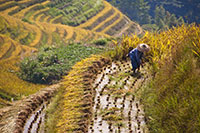The Human Right to Safe Food: China’s Continued Journey
China is developing at a rapid pace, which is good news…but when it comes to safe food, are some Chinese citizens being left behind?
 In terms of global economic development, China is a glowing success story. It had a Gross Domestic Product (GDP) of $10.36 trillion in 2014, second only to the United States, which is allowing Chinese consumers to increasingly choose foreign over domestic products, and gravitate toward foreign restaurant chains. Unfortunately, this is a luxury not everyone can afford: in 2014, 1% of the Chinese population possessed one-third of the country’s wealth.
In terms of global economic development, China is a glowing success story. It had a Gross Domestic Product (GDP) of $10.36 trillion in 2014, second only to the United States, which is allowing Chinese consumers to increasingly choose foreign over domestic products, and gravitate toward foreign restaurant chains. Unfortunately, this is a luxury not everyone can afford: in 2014, 1% of the Chinese population possessed one-third of the country’s wealth.
Food safety a right only afforded to some?
This is a particular issue when it comes to food safety. The United Nations Special Rapporteur on the right to food defines safe food as a human right. Meanwhile, the Beijing-based research company Horizon Research and Horizonkey recently polled people aged 18 to 60 in 20 cities to find that 80% are dissatisfied with food safety. The majority blamed food companies, ahead of industry associations, government and media.
An article in British newspaper The Guardian this spring noted that Chinese consumers in urban centers like Beijing and Shanghai are increasingly shopping at specialty and boutique stores which advertise safe, quality food at premium prices. Unlike consumers in more developed countries, who buy luxury food items mainly out of a desire for something rare or special, the decision for these Chinese consumers is apparently largely driven by fear. What about consumers who don’t have that kind of disposable income?
Food safety driven by consumers
The spread of food safety knowledge and tools through social media, online apps, and public databases has been a critical step in food safety worldwide, and in empowering consumers to make healthier choices.
One Australian company is hoping to expand market share in China by encouraging consumers to choose authentic Australian milk using a novel app it has adapted from the anti-counterfeiting app Authenticateit. Norco’s app program invites consumers to scan a barcode to confirm that the product is authentic, and check for recalls in real-time using live integration to global food recall portals.
GS1 Australia, a company that contributed to the development of the app, uses a Global Trade Item Number (GTIN) to track and trace products, breaking down geographic and language barriers with a common identifier. The company reports that a successful trial shipment of fresh milk to China is expected to open the door to millions of litres of fresh milk exports to China each year. The app is available to download for free from iTunes, Google Play and Chinese app store Zhushou.360, making it available to 700 million smartphone users in China.
The option to choose safe food in China is still bound by price. But the fact that alternatives even exist represents an important shift in consumer culture, and the potential to improve food safety.
About the Author
Allie Gallant is regular freelance writer and blogger with Global Food Safety Resource who is also one of our most valuable and recognizable contributors.

Categories: Trends in the Industry
Tags:



